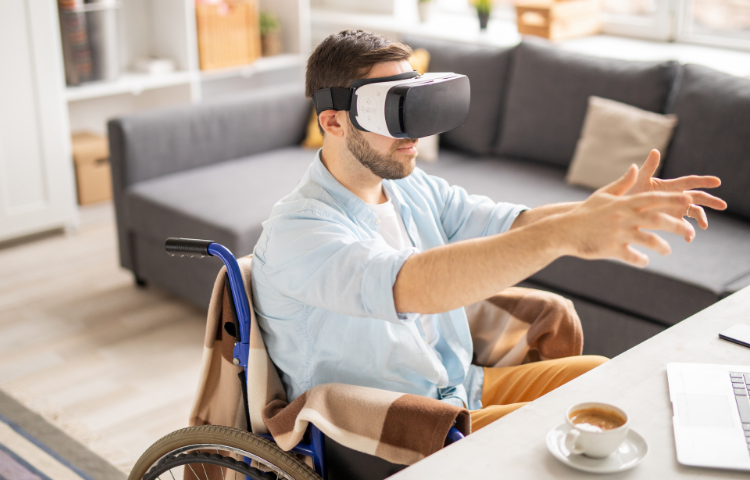

In recent years, virtual reality companies have made massive strides in bringing the once futuristic technology to consumer homes. From leading tech giants to smaller, virtual reality specific firms, virtual reality is continually being improved by these companies while becoming more affordable and beneficial to everyday consumers. In fact, according to Grand View Research, the virtual reality market is predicted to grow to $92.31 billion by 2027. That’s a compound annual growth rate of 30.2% from 2020 to 2027.
Before discussing the different uses for virtual reality at home, we first have to cover the industry’s major players.
Virtual reality has been studied for decades, but it wasn’t until the mid-2010s that the technology genuinely took-off. Starting in 2016, it seemed every tech company started getting involved and began releasing headsets. These companies include household names such as HP, Lenovo, and Dell. Let’s discuss a few of the most popular brands and headsets released in recent years.
Oculus
One of the most important events that advanced the technology and accessibility of virtual reality was in 2014 when Facebook bought the virtual reality firm Oculus VR for $2 billion. Facebook has since shortened the brand’s name to Oculus, and in 2016, Oculus made its first virtual reality headset available to the public.
Some virtual reality fans expressed discontent with the merger because Oculus VR was originally created specifically for video games. When Facebook swooped in, fans were concerned that the tech company would change the virtual reality headset’s trajectory, and it would not be gaming-specific. Despite this, the merger was integral to bringing affordable virtual reality headsets to households around the world.
For context, Oculus’s latest virtual reality headset, the Oculus Quest 2, starts at $299. To compare, the new Xbox starts at $299, and the PlayStation 5 begins at $399. All these gaming systems were released in fall 2020.
One important thing to note about the Oculus Quest 2 is the system is not tethered. A tethered headset in virtual reality means the headset needs to be connected to a computer using a cord. Tethered systems usually allow for a more robust virtual reality experience since they are attached to a computer; however, the cable may decrease mobility and distract users from fully immersing themselves in the virtual world.
Sony
Like Oculus, Sony also released its first and only virtual reality system in 2016. The system is named the Sony Playstation VR and is currently selling in a bundle pack for $349. The system is tethered, but instead of attaching to a computer, the headset tethers to a PlayStation 4 or Playstation 5. This helps make the headset easier for PlayStation users to familiarize themselves with and can be a solid choice for users looking to introduce virtual reality into their homes.
HTC
HTC also released its first virtual reality headset in 2016. The company has unveiled a variety of other headsets since 2016, with its latest being the HTC Vive Cosmos that sells for $699. This headset’s price point is higher than the aforementioned two headsets but is an excellent option for whole-room virtual reality. Whole-room virtual reality allows users to physically move in the space where they are playing, unlike seated or standing virtual reality, where users remain stationary. However, this headset also needs a powerful (and probably pricey) computer to best experience the headset’s premium features.
The use of virtual reality at home primarily started with gaming but has since branched out into other areas. Continue reading to learn more about virtual reality’s gaming features and additional ways to utilize the budding technology.
Gaming
The original and most popular use of virtual reality is for video games. No longer are gamers required to simply sit on the couch, controller in hand, and stare at the television to play their favorite games. With virtual reality, gamers can now transport to an entirely new location and physically move their body to control what happens in the game. This allows for a more life-like experience and helps gamers become more immersed in the game. Some of the best-selling VR games include Half-Life: Alyx, Beat Saber, and Job Simulator.
Fitness
Shortly after introducing virtual reality for video games, people quickly realized the potential for virtual reality to delve into the realm of fitness. Virtual reality is a great way to break up a tired workout routine. Instead of going to the gym and staring at oneself in a mirror while completing the same workout routine, virtual reality allows users to workout at locations worldwide. Also, some workout games regularly add new workout regimes to keep users engaged and challenged.
One example is the boxing game, BoxVR, which has a one-time fee of $30. In this game, players punch, squat, and dodge while working out with a real fitness instructor and listening to specially curated soundtracks. Another example of using virtual reality for fitness is the subscription-based app, Supernatural. Created by the virtual reality firm, Within, it is described as “a combination of personalized workouts and expert coaching from real-world trainers, as well as game mechanics and hit music—all set in stunning VR landscapes.”
So whether the backdrop is a glacier in Antarctica or on top of Machu Picchu, virtual reality workouts offer users inspiring and breathtaking views to power their fitness journeys.
Besides offering different virtual locations, virtual reality also brings additional benefits to exercising. There is no further equipment needed, such as dumbbells or treadmills, and there is the convenience of not having to leave home. Furthermore, since virtual reality allows users to exercise in the comfort of their homes, this removes the common insecurities people feel when working out in front of others. Virtual reality workouts provide users with interactive activities in a judgment-free space.
Mental Health
Virtual reality allows users to escape their real-life, which doctors realize is beneficial for a handful of mental health disorders. These include patients experiencing phobias, anxiety, post-traumatic stress disorder, and depression; all of which have been exacerbated due to the COVID pandemic.
An article from Scientific American says, “Over 5,000 studies reveal that VR has an uncanny ability to diminish pain, steady nerves, and boost mental health…it can be administered at home without a trained clinician.”
Virtual reality treatments, such as Psious and Limbix, work by allowing patients to leave their real world behind and adopt a healthier lifestyle. For example, this could mean treating depression and anxiety by transporting patients to the desired location, such as an island, to soak up the sun and relax on the beach. Or for individuals with phobias, patients can live vicariously through an avatar that allows them to experience life without their phobia(s). Thus, patients can see how the negative consequences that they expect to occur from their phobias never come to fruition in the virtual world. Studies on treating mental health disorders with virtual reality are relatively new but are yielding positive and promising results.
Education
Teachers are discovering virtual reality is a great resource to aid in the learning process within the classroom. Textbooks, lectures, and worksheets have a limited impact on learning as they do not offer or mimic real-world experiences. On the other hand, virtual reality helps students learn by having them actively participate.
Outside of the classroom, virtual reality at home can be used for supplemental learning or for individuals interested in learning about a specific topic. For example, Titans of Space is an app that guides players through our galaxy so that they can experience a three-dimensional tour of planets and stars. Another example is Anatomyou, which “shows the anatomical structures of various systems of the human body browsed at the minimally invasive procedures.”
So, whether students are transporting to different geographical locations and periods in history or exploring the inside of the human body, virtual reality is innovating how students learn at all levels of education. Virtual reality helps bring life-like experiences, additional context, and excitement to the learning process, all from students’ homes.
Virtual reality is an exciting and promising technology that is becoming more accessible as companies figure out how to make virtual reality more inexpensive. As accessibility increases and more consumers implement virtual reality at home, new ways of utilizing the technology will continue to be discovered.
Interested in learning more about virtual reality and potential applications? Contact us at info@quantilus.com for a consultation to learn how we can help.

In recent years, virtual reality companies have made massive strides in bringing the once futuristic technology to consumer homes. From leading tech giants to smaller, virtual reality specific firms, virtual reality is continually being improved by these companies while becoming more affordable and beneficial to everyday consumers. In fact, according to Grand View Research, the virtual reality market is predicted to grow to $92.31 billion by 2027. That’s a compound annual growth rate of 30.2% from 2020 to 2027.
Before discussing the different uses for virtual reality at home, we first have to cover the industry’s major players.
Virtual reality has been studied for decades, but it wasn’t until the mid-2010s that the technology genuinely took-off. Starting in 2016, it seemed every tech company started getting involved and began releasing headsets. These companies include household names such as HP, Lenovo, and Dell. Let’s discuss a few of the most popular brands and headsets released in recent years.
Oculus
One of the most important events that advanced the technology and accessibility of virtual reality was in 2014 when Facebook bought the virtual reality firm Oculus VR for $2 billion. Facebook has since shortened the brand’s name to Oculus, and in 2016, Oculus made its first virtual reality headset available to the public.
Some virtual reality fans expressed discontent with the merger because Oculus VR was originally created specifically for video games. When Facebook swooped in, fans were concerned that the tech company would change the virtual reality headset’s trajectory, and it would not be gaming-specific. Despite this, the merger was integral to bringing affordable virtual reality headsets to households around the world.
For context, Oculus’s latest virtual reality headset, the Oculus Quest 2, starts at $299. To compare, the new Xbox starts at $299, and the PlayStation 5 begins at $399. All these gaming systems were released in fall 2020.
One important thing to note about the Oculus Quest 2 is the system is not tethered. A tethered headset in virtual reality means the headset needs to be connected to a computer using a cord. Tethered systems usually allow for a more robust virtual reality experience since they are attached to a computer; however, the cable may decrease mobility and distract users from fully immersing themselves in the virtual world.
Sony
Like Oculus, Sony also released its first and only virtual reality system in 2016. The system is named the Sony Playstation VR and is currently selling in a bundle pack for $349. The system is tethered, but instead of attaching to a computer, the headset tethers to a PlayStation 4 or Playstation 5. This helps make the headset easier for PlayStation users to familiarize themselves with and can be a solid choice for users looking to introduce virtual reality into their homes.
HTC
HTC also released its first virtual reality headset in 2016. The company has unveiled a variety of other headsets since 2016, with its latest being the HTC Vive Cosmos that sells for $699. This headset’s price point is higher than the aforementioned two headsets but is an excellent option for whole-room virtual reality. Whole-room virtual reality allows users to physically move in the space where they are playing, unlike seated or standing virtual reality, where users remain stationary. However, this headset also needs a powerful (and probably pricey) computer to best experience the headset’s premium features.
The use of virtual reality at home primarily started with gaming but has since branched out into other areas. Continue reading to learn more about virtual reality’s gaming features and additional ways to utilize the budding technology.
Gaming
The original and most popular use of virtual reality is for video games. No longer are gamers required to simply sit on the couch, controller in hand, and stare at the television to play their favorite games. With virtual reality, gamers can now transport to an entirely new location and physically move their body to control what happens in the game. This allows for a more life-like experience and helps gamers become more immersed in the game. Some of the best-selling VR games include Half-Life: Alyx, Beat Saber, and Job Simulator.
Fitness
Shortly after introducing virtual reality for video games, people quickly realized the potential for virtual reality to delve into the realm of fitness. Virtual reality is a great way to break up a tired workout routine. Instead of going to the gym and staring at oneself in a mirror while completing the same workout routine, virtual reality allows users to workout at locations worldwide. Also, some workout games regularly add new workout regimes to keep users engaged and challenged.
One example is the boxing game, BoxVR, which has a one-time fee of $30. In this game, players punch, squat, and dodge while working out with a real fitness instructor and listening to specially curated soundtracks. Another example of using virtual reality for fitness is the subscription-based app, Supernatural. Created by the virtual reality firm, Within, it is described as “a combination of personalized workouts and expert coaching from real-world trainers, as well as game mechanics and hit music—all set in stunning VR landscapes.”
So whether the backdrop is a glacier in Antarctica or on top of Machu Picchu, virtual reality workouts offer users inspiring and breathtaking views to power their fitness journeys.
Besides offering different virtual locations, virtual reality also brings additional benefits to exercising. There is no further equipment needed, such as dumbbells or treadmills, and there is the convenience of not having to leave home. Furthermore, since virtual reality allows users to exercise in the comfort of their homes, this removes the common insecurities people feel when working out in front of others. Virtual reality workouts provide users with interactive activities in a judgment-free space.
Mental Health
Virtual reality allows users to escape their real-life, which doctors realize is beneficial for a handful of mental health disorders. These include patients experiencing phobias, anxiety, post-traumatic stress disorder, and depression; all of which have been exacerbated due to the COVID pandemic.
An article from Scientific American says, “Over 5,000 studies reveal that VR has an uncanny ability to diminish pain, steady nerves, and boost mental health…it can be administered at home without a trained clinician.”
Virtual reality treatments, such as Psious and Limbix, work by allowing patients to leave their real world behind and adopt a healthier lifestyle. For example, this could mean treating depression and anxiety by transporting patients to the desired location, such as an island, to soak up the sun and relax on the beach. Or for individuals with phobias, patients can live vicariously through an avatar that allows them to experience life without their phobia(s). Thus, patients can see how the negative consequences that they expect to occur from their phobias never come to fruition in the virtual world. Studies on treating mental health disorders with virtual reality are relatively new but are yielding positive and promising results.
Education
Teachers are discovering virtual reality is a great resource to aid in the learning process within the classroom. Textbooks, lectures, and worksheets have a limited impact on learning as they do not offer or mimic real-world experiences. On the other hand, virtual reality helps students learn by having them actively participate.
Outside of the classroom, virtual reality at home can be used for supplemental learning or for individuals interested in learning about a specific topic. For example, Titans of Space is an app that guides players through our galaxy so that they can experience a three-dimensional tour of planets and stars. Another example is Anatomyou, which “shows the anatomical structures of various systems of the human body browsed at the minimally invasive procedures.”
So, whether students are transporting to different geographical locations and periods in history or exploring the inside of the human body, virtual reality is innovating how students learn at all levels of education. Virtual reality helps bring life-like experiences, additional context, and excitement to the learning process, all from students’ homes.
Virtual reality is an exciting and promising technology that is becoming more accessible as companies figure out how to make virtual reality more inexpensive. As accessibility increases and more consumers implement virtual reality at home, new ways of utilizing the technology will continue to be discovered.
Interested in learning more about virtual reality and potential applications? Contact us at info@quantilus.com for a consultation to learn how we can help.


Need help navigating your AI journey?
Download our eBook for insights and tips to ease your way into adopting AI for your business – the smart and practical way!
Need help navigating your AI journey?
Download our eBook for insights and tips to ease your way into adopting AI for your business – the smart and practical way!